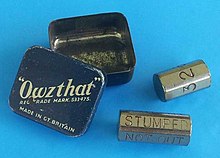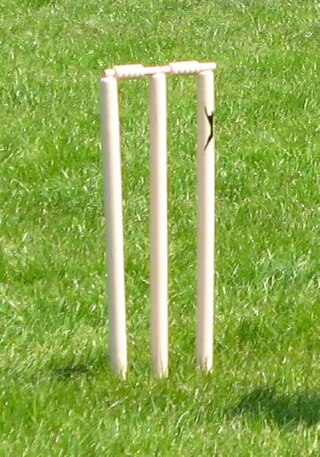Owzthat | |
|---|---|
 Owzthat dice with tin |
"Owzthat" is a dice-based cricket simulation from British firm William Lindop Ltd. It is a commercial form of pencil cricket.
Owzthat | |
|---|---|
 Owzthat dice with tin |
"Owzthat" is a dice-based cricket simulation from British firm William Lindop Ltd. It is a commercial form of pencil cricket.
Pencil cricket originated in pre-war Britain as a simple game simulating cricket by using two dice crafted by shaving paint from the end of six-sided pencils back to bare wood and writing the game's numbers and words on each side.
Lindop's name for its implementation of pencil cricket, Owzthat, is derived from a verbal appeal to the umpire, enquiring whether a batsman is out. The firm first produced the game in 1924 and patented it in 1932. The company was liquidated in 2014.
The product contains the rules on a small slip of paper and two, different, six-sided long dice made of metal with text engraved on each side of each die.
One die is referred to the batting die and has on each side 1, 2, 3, 4, 'owzthat' and 6. The second die is the bowling die and has on each side 'bowled', 'stumped', 'caught', 'not out', 'no ball', and 'L.B.W.'.
In later years the metal dice were replaced by a white plastic batting die with a green plastic bowling die, and ten red plastic disc counters added to help track fallen wickets.
Owzthat simulates a cricket game with two teams. One person can play both teams, or different people can play for each of the two teams.
Score should be kept by recording the numbers of runs achieved and tracking the number of wickets that have fallen, for example using pencil and paper.
One team bats first, using the batting die, the other decides the outcome of 'owzthat' appeals using the bowling die.
The batting side starts the game by rolling the batting die. The side facing up after the roll is interpreted as either runs scored (if a number) or as an appeal for a lost wicket if it shows 'owzthat', in which case the bowling side roll the bowler die to determine the result of the appeal.
If 'Not Out' is rolled, then the batsman continues play, if 'No Ball' is shown then the batsman receives one run and then continues to play. If 'bowled', 'stumped', 'caught', or 'L.B.W.’ are rolled then a wicket falls, implying that the batsman is out and then next batsman should come to the crease, if the team has wickets remaining.
Although not specifically stipulated by the rules included with the product, a cricket innings usually ends when 10 wickets have fallen. The other side then plays its batting innings. The team with the most runs after both have played a batting innings wins.
The rules do not mention real-life formats such as limited-over innings or multiple-innings matches, so players are free to simulate those rules if they so wish.

Bowling, in cricket, is the action of propelling the ball toward the wicket defended by a batter. A player skilled at bowling is called a bowler; a bowler who is also a competent batter is known as an all-rounder. Bowling the ball is distinguished from throwing the ball by a strictly specified biomechanical definition, which restricts the angle of extension of the elbow. A single act of bowling the ball towards the batsman is called a ball or a delivery. Bowlers bowl deliveries in sets of six, called an over. Once a bowler has bowled an over, a teammate will bowl an over from the other end of the pitch. The Laws of Cricket govern how a ball must be bowled. If a ball is bowled illegally, an umpire will rule it a no-ball. If a ball is bowled too wide of the striker for the batsman to be able to play at it with a proper cricket shot, the bowler's end umpire will rule it a wide.

Leg before wicket (lbw) is one of the ways in which a batter can be dismissed in the sport of cricket. Following an appeal by the fielding side, the umpire may rule a batter out lbw if the ball would have struck the wicket but was instead intercepted by any part of the batsman's body. The umpire's decision will depend on a number of criteria, including where the ball pitched, whether the ball hit in line with the wickets, the ball's expected future trajectory after hitting the batsman, and whether the batsman was attempting to hit the ball.
The Laws of Cricket is a code that specifies the rules of the game of cricket worldwide. The earliest known code was drafted in 1744. Since 1788, the code has been owned and maintained by the private Marylebone Cricket Club (MCC) in Lord's Cricket Ground, London. There are currently 42 Laws, which describe all aspects of how the game is to be played. MCC has re-coded the Laws six times, each with interim revisions that produce more than one edition. The most recent code, the seventh, was released in October 2017; its 3rd edition came into force on 1 October 2022.

The wicket-keeper in the sport of cricket is the player on the fielding side who stands behind the wicket or stumps being watchful of the batsman and ready to take a catch, stump the batsman out and run out a batsman when occasion arises. The wicket-keeper is the only member of the fielding side permitted to wear gloves and external leg guards. The role of the keeper is governed by Law 27 and of the Laws of Cricket.

In cricket, the term wicket has several meanings:

This is a general glossary of the terminology used in the sport of cricket. Where words in a sentence are also defined elsewhere in this article, they appear in italics. Certain aspects of cricket terminology are explained in more detail in cricket statistics and the naming of fielding positions is explained at fielding (cricket).

French cricket is a form of cricket that creates a game similar to catch. The game can be played socially at picnics and parties or on parks and beaches. It is a form of cricket that can include children of varied ages.
Cricket is a sport that generates a variety of statistics.

In cricket, a dismissal occurs when a batter's innings is brought to an end by the opposing team. Other terms used are the batter being out, the batting side losing a wicket, and the fielding side taking a wicket. The ball becomes dead, and the dismissed batter must leave the field of play for the rest of their team's innings, to be replaced by a team-mate. A team's innings ends if ten of the eleven team members are dismissed. Players bat in pairs so, when only one batter remains who can be not out, it is not possible for the team to bat any longer. This is known as dismissing or bowling out the batting team, who are said to be all out.
Cricket is a multi-faceted sport with different formats, depending on the standard of play, the desired level of formality, and the time available. One of the main differences is between matches limited by time in which the teams have two innings apiece, and those limited by number of overs in which they have a single innings each. The former, known as first-class cricket if played at the senior level, has a scheduled duration of three to five days ; the latter, known as limited overs cricket because each team bowls a limit of typically 50 overs, has a planned duration of one day only. A separate form of limited overs is Twenty20, originally designed so that the whole game could be played in a single evening, in which each team has an innings limited to twenty overs.

In cricket, a scorer is someone appointed to record all runs scored, all wickets taken and, where appropriate, the number of overs bowled. In professional games, in compliance with Law 3 of the Laws of Cricket, two scorers are appointed, most often one provided by each team.

The 2005 Ashes series was that year's edition of the long-standing cricket rivalry between England and Australia. Starting on 21 July 2005, England and Australia played five Tests, with the Ashes held by Australia as the most recent victors. The final result was a 2–1 series win for England, who succeeded in their biennial attempt to win the urn.
The Bangladeshi cricket team toured Sri Lanka for three One Day International cricket matches and two Test cricket matches in August and September 2005. The Bangladeshi team was coming off a moderately successful tour of England, as they had pushed Australia close in one ODI and beat them in another. However, they had still lost five out of six matches in the NatWest Series, both of the Test matches, and remained at the bottom of both the ICC Test Championship and ICC ODI Championship. The hosts Sri Lanka, meanwhile, were undefeated in home ODI tournaments since February 2004, and in home Test series since March 2004, both against top-ranked Australia. Their win in the Indian Oil Cup a month before this series saw them into second place in the ODI Championship, but they are only ranked sixth in Tests.
Armchair cricket is a card game that is inspired by the bat and ball sport cricket. It is played by either two or four people. Depending on the version of the game being played, a game can last a few minutes to several hours. It was produced commercially in England but is no longer made.
Crocker is a team sport played between two large teams. Its origins are in cricket and baseball. It also makes the use of a rugby ball, or a soccer ball which may explain its name. It is a casual sport not played formally, but often found on British summer camps.

Ernie Toshack was a member of Donald Bradman's famous Australian cricket team, which toured England in 1948 and was undefeated in their 34 matches. This unprecedented feat by a Test side touring England earned Bradman's men the sobriquet The Invincibles.
The Second Test of the 1948 Ashes series was one of five Tests in The Ashes cricket series between Australia and England. The match was played at Lord's in London from 24 to 29 June, with a rest day on 27 June 1948. Australia won the match by 409 runs to take a 2–0 lead, meaning that England would need to win the remaining three matches to regain The Ashes.

Ian Johnson was a member of Donald Bradman's famous Australian cricket team, which toured England in 1948. Bradman's men went undefeated in their 34 matches; this unprecedented feat by a Test side touring England earned them the sobriquet The Invincibles.

The 1946–47 Ashes series consisted of five cricket Test matches, each of six days with five hours play each day and eight ball overs. Unlike pre-war Tests in Australia, matches were not timeless and played to a finish. It formed part of the MCC tour of Australia in 1946–47 and England played its matches outside the Tests in the name of the Marylebone Cricket Club. The England team was led by the veteran Wally Hammond and his vice-captain Norman Yardley with the strong batting line up of Len Hutton, Cyril Washbrook, Bill Edrich, Denis Compton and Joe Hardstaff, but a weak bowling attack that relied on pre-war bowlers like the 37-year-old Bill Voce of Bodyline fame and the mercurial leg-spinner Doug Wright. The two successes of the tour were the newly capped Alec Bedser, who would carry the England bowling attack until 1955, and Godfrey Evans who would be England's first choice wicketkeeper until 1959. England had drawn the Victory Tests 2–2 in 1945 and were thought to be equal in strength, but Hammond lost 3–0 to Don Bradman's Australian team which had only two other pre-war players – Lindsay Hassett and Sid Barnes, who had played 5 Tests between them – and was packed with fresh talent in the shape of Arthur Morris, Keith Miller, Ray Lindwall, Colin McCool, Ernie Toshack and Don Tallon. There were several controversial umpiring decisions which assumed greater significance as they favoured Australia and in particular Don Bradman.

The 2019 Ashes series was a series of Test cricket matches played between England and Australia for The Ashes in August and September 2019. The venues were Edgbaston, Lord's, Headingley, Old Trafford and The Oval.